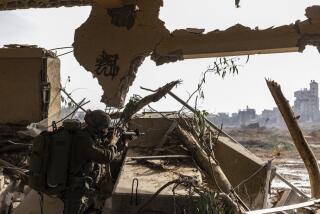Lancaster’s crime-fighting plane puts focus on civil rights
A plan to patrol Lancaster with an airplane that would record the movements of people on the ground has stoked the concerns of civil liberty advocates while being embraced by some residents who say they would support any means to crack down on crime.
The piloted plane would circle the High Desert town 16 hours a day, recording video footage that would be transmitted to law enforcement officials, according to the plan. The plane, its designer said, would fly at an altitude of about five miles, making it all but invisible to residents.
City officials said they believe Lancaster would be the first city in the nation to employ such an aggressive aerial surveillance system
A high-tech video camera could spot a home invasion robbery, detect car accidents and dispatch the appropriate personnel, and track unsuspecting criminals, according to local city and law enforcement officials. They contend that it would also improve response time.
“This is an incredibly valuable resource that can be utilized at any minute for legitimate reasons,” said Lancaster Mayor R. Rex Parris, who is championing the new program.
But some residents, community leaders and civil rights advocates fear the system would border on government-sanctioned snooping and could be used to spy on law-abiding citizens as they go about their daily activities, even peeping into their backyards.
“If there is nowhere for criminals to hide, there would be no place for anyone to hide,” said Peter Bibring, a staff attorney for the American Civil Liberties Union of Southern California.
In recent years, government-funded surveillance systems have been installed in the streets, plazas and shopping malls of dozens of cities nationwide, including Los Angeles, San Francisco, and Sacramento. In most cases, the municipalities have called the systems a deterrent to crime, but some have faced a backlash.
In Sacramento, where city officials voted earlier this year to use almost $615,000 in federal grant money to install surveillance cameras in high-crime areas, privacy advocates worried that the initiative could lead to racial profiling. In the seaside Marin County town of Tiburon, where authorities attribute last year’s crime surge to outsiders, officials have proposed installing cameras on the two roads in and out of town. They would photograph the license plate of every vehicle entering and leaving. Opponents fear that drivers’ privacy might be compromised and license plate information might be misused.
Lancaster is planning a one-week test in March, potentially followed by a one-year pilot program. The start-up cost would be about $500,000, according to Parris. The mayor said the goal was to raise private funds to cover the expense.
“It will be totally invisible” to people on the ground, said Dick Rutan, an aviator and the mayor’s personal pilot who is helping to design the surveillance aircraft. “They can’t see it. They can’t hear it. We can instantaneously identify perpetrators and automatically track them for law enforcement.”
Los Angeles County Sheriff’s Capt. Axel Anderson said it would be a powerful law enforcement tool, noting that he preferred the program be identified as a “sky sentinel” rather than “eye in the sky,” as some people in Lancaster have referred to it.
“It’s not some big eye up there watching everything that everybody is doing,” Anderson said.
The Sheriff’s Department would operate the system, and determine who and what should be monitored, Parris said. Designated deputies would be the only personnel allowed to view the recordings. “I’m not going to be looking in people’s backyards,” Parris said.
The mayor said there would be times when certain individuals might intentionally be observed. “There are some people we will be spying on,” Parris said. “If we need to put a house under surveillance, there is no reason to tie up four police officers to do it.”
The ACLU’s Bibring said safeguards against potential misuse of the system would need to include ongoing oversight of the program by an outside body, and prompt destruction of recordings that were not pertinent to an investigation. Parris said legal experts and community leaders would be asked to help draft guidelines for the program.
Elke Kolodinski, a graduate of USC’s School of Policy, Planning and Development, helped prepare a study last year on the effects of video surveillance on crime in Los Angeles. Kolodinski said the study found that video surveillance did not have “any statistically significant effect in reducing overall crime” in the targeted areas.
A similar study conducted last year by the UC Berkeley School of Law to study the effectiveness of 71 surveillance cameras installed in high-crime areas in San Francisco found that the technology had little overall effect on crimes such as homicide, drug dealing and prostitution. However, there was a measurable decline in crimes such as purse-snatching and auto burglary within 100 feet of the cameras, the study found.
Antelope Valley blogs have been ablaze with chatter about the new program, both for and against.
Matthew Keltner, 28, a Lancaster high school teacher, wrote: “If having a measure of surveillance overhead is going to make the criminal-minded uncomfortable, and think twice before settling in Lancaster, or engaging in criminal activity, then what’s wrong with it?
“I could care less if someone sees me doing water aerobics in my grandmother’s pool,” he added.
More to Read
Sign up for Essential California
The most important California stories and recommendations in your inbox every morning.
You may occasionally receive promotional content from the Los Angeles Times.











